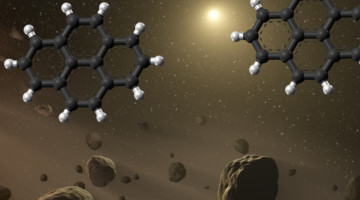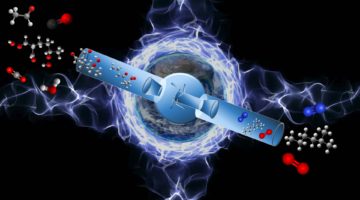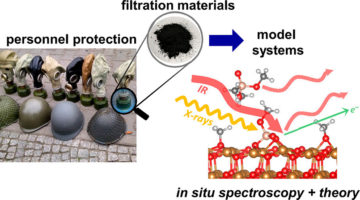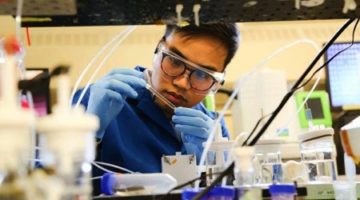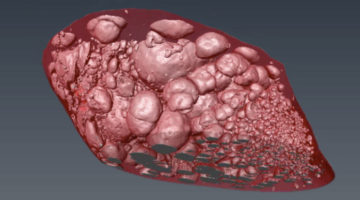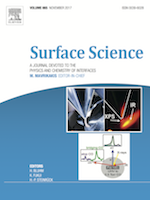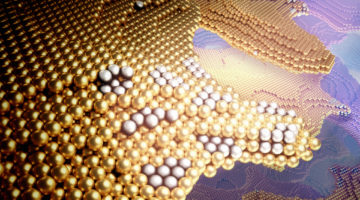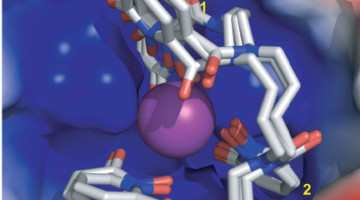Berkeley Lab has a well-storied expertise in exploring samples of extraterrestrial origin. This research—which has helped us to understand the makeup and origins of objects within and beyond our solar system—stems from long-standing core capabilities in structural and chemical analyses and measurement at the microscale and nanoscale. Read more »
Chemical Sleuthing Unravels Possible Path to the Formation of Life’s Building Blocks in Space
Experiments retrace the steps leading to the creation of complex hydrocarbons in space, showing pathways to forming 2D carbon-based nanostructures in a mix of heated gases. The study could help explain the presence of pyrene, a polycyclic aromatic hydrocarbon, and similar compounds in some meteorites. Read more »
Unraveling the Complexities of Auto-Oxidation
Researchers directly observed the formation of highly oxygenated molecules—the elusive products of auto-oxidation reactions relevant to combustion and atmospheric chemistry. A better understanding of auto-oxidation mechanisms could lead to better engines, less air pollution, and improved climate models. Read more »![]()
![]()
Ingredients for Life Revealed in Meteorites That Fell to Earth
Two wayward space rocks, which separately crashed to Earth in 1998 after circulating in our solar system’s asteroid belt for billions of years, share something else in common: the ingredients for life. They are the first meteorites found to contain both liquid water and a mix of complex organic compounds such as hydrocarbons and amino acids. Read more »
Studying Gas Mask Filters So People Can Breathe Easier
Scientists have put the x-ray spotlight on composite materials in respirators used by the military, police, and first responders. The results provide reassuring news about the effectiveness of current filters and provide fundamental information that could lead to more advanced gas masks as well as protective gear for civilian applications. Read more »
New Catalyst Gives Artificial Photosynthesis a Big Boost
Researchers have created a new catalyst that brings them one step closer to artificial photosynthesis — a system that would use renewable energy to convert carbon dioxide (CO2) into stored chemical energy. Read more »
PepsiCo Explores Future Food Products at the ALS
Global food and beverage giant PepsiCo has been using ALS tomography beamline 8.3.2 to understand more about the chemical structure and behavior of their starch-based snack foods, with the goal of creating a whole new category of snacks that consumers cook at home in their own microwaves. Read more »![]()
CO Adsorption on Pd(100) Studied by Multimodal Ambient Pressure X-Ray Photoelectron and Infrared Reflection Absorption Spectroscopies
The first combined infrared spectroscopy and ambient-pressure XPS study was demonstrated at Beamline 11.0.2. The in situ vibrational and core-level spectroscopies in the Torr pressure range offer complementary information on the properties of surfaces and adsorbates while closing the pressure gap between laboratory measurements and applications. The multimodal spectroscopy also allowed the identification of the C 1s binding energy and quantification of an uncommon atop CO species on a Pd(100) surface. Read more »
A Closer Look at Dynamic Restructuring in Catalysts
Researchers have structurally and chemically “visualized” the surface of a silver–gold alloy as it reorganizes itself during catalytic activation. The insights gained from this methodology can lead to improved catalysts for energy-intensive industrial applications, thereby increasing efficiency and reducing waste. Read more »![]()
![]()
Protein Complex Shows Promise for Berkelium Separation
Scientists found that the element berkelium breaks form with its heavy-element peers by taking on an extra positive charge when bound to a synthetic organic molecule. This property could help scientists develop better methods for handling and purifying nuclear materials. Read more »
- « Previous Page
- 1
- …
- 8
- 9
- 10
- 11
- 12
- 13
- Next Page »

